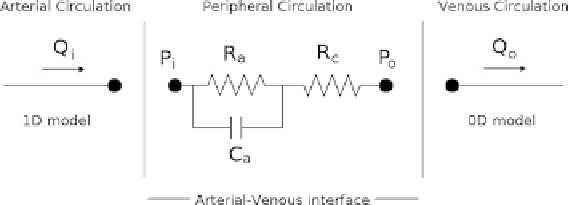Biomedical Engineering Reference
In-Depth Information
we have
N
cg
,
j
n
=
1
Q
sa
|
j
,
n
=
0
j
=
1
,...,
N
jn
,
(9.58)
P
sa
|
j
,
n
=
P
sa
|
j
,
1
n
=
2
,...,
N
cg
,
j
j
=
1
,...,
N
jn
,
(9.59)
where the pair
indicates the restriction of the flow rate and pressure of
a given systemic artery at the junction
j
.
The geometrical and mechanical parameters used in the 1D model of the arterial
tree agree with the model proposed in [1] and are presented in Table 9.2.
(
Q
sa
|
j
,
P
sa
|
j
)
9.4.4 0D model for the arterioles and capillaries
The peripheral circulation is represented through Windkessel models [54, 56] char-
acterized by three elements
R
c
,
R
a
and
C
a
to model the capillaries and arterioles,
respectively (see Fig. 9.5).
In Fig. 9.5
denote the quantities at the input and output, re-
spectively. For a single Windkessel element
k
these quantities are
(
Q
i
,
P
i
)
and
(
Q
o
,
P
o
)
(
Q
sa
|
w
,
k
,
P
sa
|
w
,
k
)
and
. The former pair represents the quantities at the arterial segment
converging to the corresponding Windkessel segment
k
, whereas in the latter pair
we have the quantities from the venous side. Then the balance equations for these
models are the following
(
Q
w
,
k
,
P
w
,
k
)
R
a
C
a
d
dQ
sa
|
w
,
k
dt
1
R
c
R
a
C
a
=
dt
(
P
sa
|
w
,
k
−
P
w
,
k
)
(9.60)
Q
sa
|
w
,
k
+(
P
sa
|
w
,
k
−
P
w
,
k
)
−
(
R
c
+
R
a
)
k
=
1
,...,
N
w
,
(9.61)
Q
sa
|
w
,
k
=
=
,...,
.
Q
w
,
k
k
1
N
w
(9.62)
The Windkessel element is a model for the arterial-venous interface. Thus the
P
sa
|
w
,
k
is the pressure from the arterial side (at the input of the compartment) while
P
w
,
k
is
the pressure from the venous side (at the output of the compartment), more precisely
Fig. 9.5.
The 0D Windkessel model for the peripheral circulation



